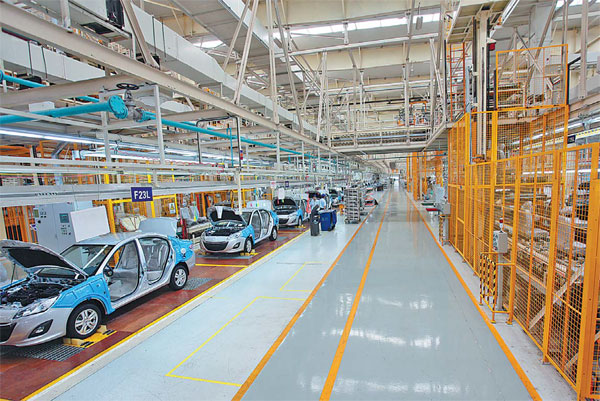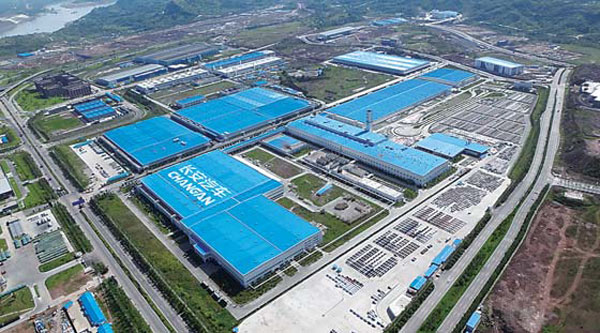Battlefield where the tanks are cars

Chinese carmaker looks overseas as cars saturate home market
For Zhu Huarong, competition in China's car industry is akin to war, and in one of its battles domestic automakers are fighting for market share overseas.
"China's domestic car industry is suffering from overcapacity now," says Zhu, president of Changan Automobile Co Ltd. "As one of the largest domestic carmakers, we are putting a lot into expanding overseas."
| The assembly line of Changan Automobile Co Ltd in Chongqing. The company is expanding into developed countries and trying to make mid and high-end vehicles. Photos provided to China Daily |
| Changan's headquarters in the Jiangbei district of Chongqing. |
Zhu, 50, is speaking in Changan's headquarters in the Jiangbei district of Chongqing, one of the most bustling areas of the city.
"For successful overseas expansion, three important steps are needed. First, developing overseas business from less developed countries and regions and then to developed areas. Second, to produce more green energy modes and cars that can attract young people, and third to produce more high-end cars.
"The cars China makes are kind of stereotyped as cheap and low-end. Our ambition is to become a mid to high-end carmaker and to crack overseas markets."
Zhu, who was once the vice-president of the group and was mainly in charge of overseas business, says Changan wants be the world's best carmaker.
"At the moment our major overseas markets are Africa and Southeast Asia. If we are to become a global car giant we need to expand into developed countries and make mid and high-end vehicles."
Last year Changan had a profit of 3.5 billion yuan ($561 million; 529 million euros), more than 110 percent higher than in 2013, and overseas markets accounted for 5 percent of the company's revenue.
"We are banking on our sales growing overseas in future, but it's hard to say how much they will grow by," Zhu says.
"Our strategy in going about that task is proactive and stable because going overseas presents many challenges in terms of political uncertainties and exchange rate fluctuation.
"Generally we will first enter the less developed overseas markets, where the costs of operating a brand are lower than in the United States and in the European Union. After gaining brand recognition we will venture into developed markets such as the US and the EU."
Zhu cites Russia as an example of the complexities of going overseas.
"Emerging markets like Russia and Brazil are full of opportunities for Chinese carmakers because people there are not addicted to Western brands. That's why we decided to set up a factory in Russia. But because of the fluctuations in oil prices recently, investment returns from Russia are not that promising, and we have had to delay plans to expand there."
Changan now has three factories overseas and is building three others in Chile, Colombia and Vietnam.
As part of its drive to gain a foothold in overseas markets the company is preparing for big things, such as introducing its green-energy car model. It plans to unveil an energy-efficient car on March 20, Zhu says, without giving more details.
Zhu studied engineering at the Beijing Institute of Technology. He graduated in 1986 and has worked for Changan since then.
Looking back over his 29 years in the car industry, his most fulfilling moment was finally seeing Changan produce its own branded cars in 2009, he says.
"When Changan used to make cars for foreign companies or for joint ventures, such as Changan Ford, there was little sense of fulfillment. It's vital for a company to own its own brand and core technologies."
When he went abroad for the first time, to visit Japan in 1987, he says, there was a huge gap between Changan and its foreign competitors. Suzuki then made about 800,000 cars a year, while Changan made just 200.
Last year the group made 2.54 million cars carrying its own brands, accounting for more than 50 percent of its car sales.
Zhu says Chongqing is an ideal base, given that the city has a complete industrial chain for making motor vehicles and a big pool of skilled labor.
In the car industry, possessing strong research and development is crucial for keeping or building a good competitive edge, he says.
To develop its brand, Changan is setting up more R&D centers worldwide. Since setting up its first global R&D center in Turin in 2003, it has set up five more in Chongqing, Italy, Japan, Britain and the US.
More than 90 percent of the employees at the overseas R&D centers are non-Chinese, most of them engineers. The overseas centers are mainly responsible for the R&D of Changan cars to be sold in China. The Italian center does about 80 percent of the company's design work, Zhu says.
"R&D is always our biggest focus and we will continue to invest heavily in it."
One of the biggest challenges for the company is to reduce vehicle emissions, and the R&D centers have played a key role in this, Zhu says. Since the centers were set up the company has been able to cut emissions by 40 percent with its greener vehicles.
About 10 percent of Changan's 80,000 employees, in 16 countries and regions, work in its R&D branches, the company says.
On the problem of overcapacity in China, Zhu says: "Last year China produced about 38 million cars, but the demand was for just 25 million. Many automakers will suffer from this overcapacity and are likely to fold.
"But these problems throw up some opportunities, too. In the process of industry consolidation, we are looking to mergers and acquisitions, including some in the EU and in the US."
The group aims to develop e-commerce business by using Chinese online shopping websites such as JD.com and Tmall.com to promote its sales worldwide, he says.
Zhu has a microblog and says he receives feedback from customers that way.
"In developing our cars we need to be more customer-oriented, which in turn will provide sustainable development."
Zhu sees young people as an important consumer demographic for the company's cars in the future, and says that the R&D centers are urged to emphasize fashionable design.
"Even if there is overcapacity at the moment, as living standards improve in China the demand for cars will rise. The Chinese market can be a backbone for domestic brands like Changan.
"I am confident that it will take no more than 10 years for the Chinese car industry to catch up with or even surpass foreign carmakers in sales and brand recognition. There is no doubt that Changan will definitely be one of them."
Contact the writers through huhaiyan@chinadaily.com.cn
(China Daily European Weekly 03/20/2015 page23)
Today's Top News
- Japan tempting fate if it interferes in the situation of Taiwan Strait
- Stable trade ties benefit China, US
- Experts advocate increasing scope of BRI to include soft power sectors
- New engine powers cargo drone expansion
- China to boost green industry cooperation
- Manufacturing PMI rises in November
































